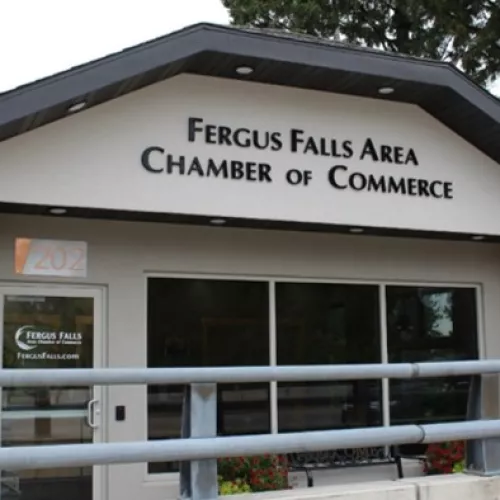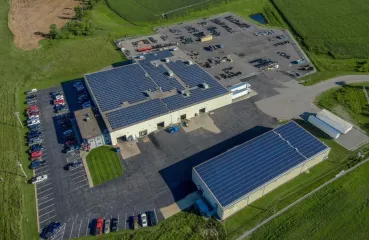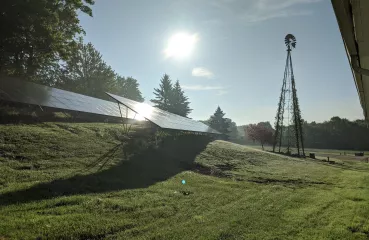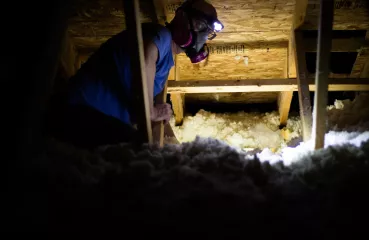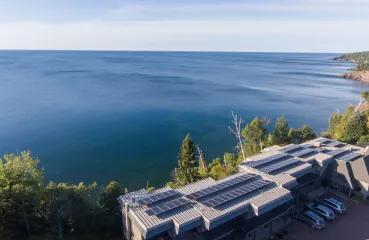Event Highlights
Lisa Workman, Fergus Falls Chamber of Commerce
- The Fergus Falls Chamber of Commerce completed a recent energy project that is saving 50% on heating costs, in addition to improving comfort and safety!
- The Chamber took advantage of Otter Tail Power’s rebates to help pay for the project, which included insulation, lighting upgrades, an air source heat pump, and a high efficiency furnace.
Brandon Johnson, Otter Tail Power Company
- Otter Tail Power provides rebates and, in some cases, low-interest financing, to help pay for a variety of energy saving upgrades for businesses. You can learn more about OTP’s programs by contacting Brandon or perusing the OTP website.
- Converting old lighting to LEDs is a relatively simple way for businesses to save money on energy, with a quick payback period. OTP’s lighting rebates range from $0.10 - $0.60 per watt saved. Air Source Heat Pumps (ASHPs) are a highly efficient way to heat and cool your building. OTP offers generous rebates ($500-$900 per ton) on ASHPs. Special low electric rates and low interest financing may also apply. If your business is interested in electric vehicles, OTP is offering a $400 rebate on the installation of a level 2 charger, as well as extra low off-peak charging rates for EVs.
- Finally, a quick reminder that for OTP’s 2020 rebates, applications for installations need to be submitted to OTP by January 31, 2021.
Peter Lindstrom, Clean Energy Resource Teams
- Property Assessed Clean Energy (PACE) is a program that helps commercial property owners finance energy upgrades to their new or existing buildings. Owners pay for the project as a special assessment on their property taxes. PACE financing helps overcome barriers to doing energy-related projects. It eliminates high up-front costs, reduces dependence on credit, and allows for comprehensive projects.
- In Minnesota, PACE can be used for energy upgrades to commercial, industrial, nonprofit, and multifamily housing properties. Eligible projects include energy efficiency, renewable energy, and electric vehicle infrastructure projects. You use some of the savings from the project to pay for the assessment!
- The fine print: You must be current on mortgage and taxes, must not be in bankruptcy proceeding, and must not have any federal or state liens against the property. The term will not exceed the useful life of the project, and the amount financed can’t exceed 20 percent of the appraised property value.
- Around 250 projects in Minnesota have made use of the PACE program, including a wide range of businesses across the state, from the Blue Line Travel Center in Worthington, to Paul’s Handyman Services in Redwing, to the Cliff Dweller Hotel in Cook County.
- To learn more, contact Peter Lindstrom or Melissa Birch, or check out CERTs’ PACE webpage.
Fritz Ebinger, Clean Energy Resource Teams
- USDA's Rural Energy for America Program (REAP) grants and guaranteed loans are another way to help fund your energy efficiency and renewable energy projects. Entities eligible for REAP grants include farms, rural small businesses (including those in Fergus Falls), rural electric cooperative, and tribal entities. Grants can cover up to 25% of eligible project costs, including labor, equipment, fees, and permits. These grants can be combined with PACE financing.
- Grants are awarded through a competitive process, but lately a high percentage of applicants have been awarded grants, so now is a good time! Application deadlines are October 31 and March 31.
- What about tax incentives? Commercial buildings making energy efficiency improvements may be eligible for a square-footage based tax deduction, if their improvements reduce building energy costs by 50% relative to an ASHRAE standard.
- In addition, many folks have heard about the federal Energy Investment Tax Credit (ITC) for solar. For 2020, this tax credit is 26%. In 2021, it tapers to 22%, and in 2022 to 10%. In addition, solar installations are eligible for accelerated depreciation, providing additional tax benefits: MACRS 5-year property depreciation schedule -OR- 100% bonus depreciation for the installation year.
- Learn more about USDA REAP grants and energy tax incentives by contacting Fritz Ebinger or checking out the CERTs page for farms and rural small businesses.
Featured Resources
We encourage reuse and republishing of this article. All Clean Energy Resource Teams news posts are made available under the Creative Commons Attribution license, meaning you can share and adapt the work as long as you give us credit. We'd also love it if you link back to the original piece. Have questions or want to chat? Drop us a line.

